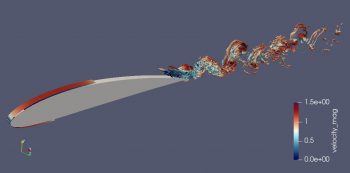Success Story: A novel framework for online estimation of the uncertainties in turbulent flow statistics
Success story # Highlights:
- Keywords:
- Turbulence simulation
- Time-averaging uncertainty
- In-situ algorithms
- Industry sector: Aerospace, Automotive, Energy
- Key codes used: Nek5000, UQit, In-Situ Toolbox

Organisations & Codes Involved:

The Swedish e-Science Research Centre (SeRC) is a national e-science initiative, funded by the Swedish government with the Strategic Research Area Initiative, dedicated to provide e-infrastructure support and to improve important e-science software on future HPC platforms. The largest part of this support is provided by giving researchers access to the national computational experts and infrastructure and to promote collaboration between scientific experts and computational experts.

Fraunhofer SCAI is a theoretical and applied research centre with a long experience in the lead of and participation in data-driven projects with industry, both in publicly funded projects as well as projects funded by industry. Besides, SCAI collaborates with industry on the utilisation of modern data analysis approaches in industrial applications such as (virtual) product development, condition monitoring systems, and predictive maintenance.
Nek5000 is an open-source code for the simulation of incompressible flows. Nek5000 is used in a broad range of applications, including the study of thermal hydraulics in nuclear reactor cores, the modelling of ocean currents, and the simulation of combustion in mechanical engines.
UQit is an open-source Python package for uncertainty quantification (UQ). The designed structure and included tools are aligned with the specifications and demands of Computational Fluid Dynamics (CFD) applications. UQit is designed to be non-intrusively linked to any CFD solver through user-provided interfaces.
The In-Situ Data Analysis Toolbox provides a prototyping environment in Python for the development and evaluation of new data-driven and in-situ algorithms.
scientific Challenge:
Computing turbulence statistics play a vital role in understanding the relevant physics and the formal characterisation of turbulent flows. In practice, statistical terms are computed combining different sample-mean estimators that are, however, uncertain due to the finite number of time samples taken from the CFD simulations. One of the main challenges for quantifying the uncertainty in sample-mean estimators is to accurately account for the fact that the time samples for a turbulent flow quantity at any spatial point are autocorrelated up to a generally unknown number of lags. Another main challenge is that storing the time series data of turbulent flows for the UQ analyses to be done as a post-processing step, is not computationally efficient, especially for the large-scale simulations.
Solution:
Together, the involved partners developed a framework for in-situ (online/streaming) estimation of the time-averaging uncertainties in turbulent flow simulations. The framework consists of a low-storage updating UQ algorithms, adapters for sampling from a CFD solver, and interfaces between the CFD and UQ suites. The UQ algorithms include the updating version of the non-overlapping batch and batch-mean batch-correlation methods, as well as a novel updating method for sample-estimating and modelling the autocorrelation functions. The resulting framework is computationally efficient, leads to accurate uncertainty estimations, and is general, meaning that it can be applied to any CFD solver and be used on any computing system.
Scientific impact of this result:
The common approaches to estimate the uncertainties in time-averaged values are not optimal, in terms of accuracy and capability, to be used in-situ during the course of simulations. In batch-based methods, an appropriate batch size for which the uncertainty estimates are accurate is not known in advance of the simulation. In contrast, techniques that are based on modelling the auto-correlation function are less prone to this bias. Nonetheless, they need access to the entire time-series at once which is not feasible for large scale simulations.
To overcome the drawbacks of the existing methods, we proposed a novel updating method for sample-estimating and modelling the autocorrelation functions that can be applied during the runtime of a simulation. This way, the turbulent flow data can be processed step by step as it is generated by the CFD solver and while it is still available in memory of the HPC system.
As a result, we were able to accurately estimate the uncertainty in the sample-mean estimator at all mesh points for a highly resolved turbulent CFD simulation (see Fig. 1). Compared to standard offline approaches, this can provide a higher spatial resolution and accuracy of the results leading to better insights into turbulent flows.
Benefits for further research:
- Strong reduction of data I/O during and after the simulation (to less than 1%)
- Flexibility in defining the regions of interest (in the flow domain) in which the UQ techniques are applied to the flow quantities.
- Monitoring of intermediate UQ results during the runtime of the simulation
- Very small computational overhead due to the UQ techniques (less than 5%)
PRODUCTS/SERVICES:
- Software tools for in-situ UQ of turbulent flow simulations
- Consulting activities on in-situ UQ for autocorrelated and cross-correlated time-series data
- The machinery and framework can be used for developing in-situ version of various data-driven techniques
Unique value of each service:
The software tool provides accurate in-situ estimators for the uncertainty in turbulent flow statistics. It can be attached to any flow solver that provides a ParaView Catalyst interface and executed together with the simulation. This leads to a strong reduction of data I/O and an increase of the spatial resolution of the output while maintaining a similar accuracy of results compared to state-of-the-art offline UQ estimators.

If you have any questions related to this success story, please register on our Service Portal and send a request on the “my projects” page.

